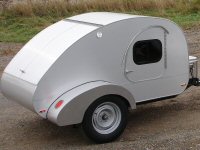LP Gas Refrigerator
28 posts
• Page 1 of 2 • 1, 2
LP Gas Refrigerator
I bought a 3 way LP Gas Refrigerator Norcold 323 for the Teardrop I am building. Was this the wrong thing to do? I planed on putting a LP tank on the front of the trailer and running a 12 ft hose under the trailer and up through the floor to the Refrigerator. I was also going to put in a Tee so I could use a LP stove. Has anyone done this ?
- Gene S
- Teardrop Inspector
- Posts: 3
- Images: 3
- Joined: Wed Jun 16, 2010 11:19 pm
- Location: Troy,Oh
Good morning Gene and welcome.
Mounting an LP Ref in a tear has been discussed here many times and the idea has been abandoned by many people.
In fact I don't know of anyone here or on any other Teardrop board, or in the real world who has a Teardrop Trailer with one in it...I could be wrong.
I'm an Master RV Technician with over 35 years experience and I have tried and abandoned the idea long ago.
Not that It cannot be done, just that there are to many dangers for me that I'm not willing to take a chance with nor give "How to" advice for.
First is the excessive heat that these Ref's put out on any of the 3 sources.
Then there's the open flame in the center of the cabin.
The risk of Carbon monoxide.
Venting, very important, If the Ref will have the door facing out in the galley there will have to be a vent at the top and that vent will be at or near the hinge. A great area for leaks.
With all the requirements that are needed for venting, space becomes an issue.
And always the risk of an LP leak.
Another factor to be concerned with is that the Norcold N323 has all the controls in the back of the Ref, as do many of the small 3 ways. Which means that an access panel must be made directly into the cabin to turn the unit on or off.
Besides being inconvenient (you may have to remove the mattress to gain access) these controls are directly in the area of the heat and Carbon Monoxide.
If that access panel...that is in an inconvenient place is not re secured properly you have direct access from the unit to the cabin.
As it is you would have an open flame within a few inches of your mattress & you.
I would mount the Ref in the galley but make it so it can be pulled when you get to the campground and ran outside the trailer.
Your going to get several suggestions on "how to do this" from people who have never done it before.
I have never done it either, but have tried. Excessive Heat, Carbon Monoxide in the center of the Cabin and there effects were the show stoppers for me. Not the instalation.
Happy Trails
Len
Mounting an LP Ref in a tear has been discussed here many times and the idea has been abandoned by many people.
In fact I don't know of anyone here or on any other Teardrop board, or in the real world who has a Teardrop Trailer with one in it...I could be wrong.
I'm an Master RV Technician with over 35 years experience and I have tried and abandoned the idea long ago.
Not that It cannot be done, just that there are to many dangers for me that I'm not willing to take a chance with nor give "How to" advice for.
First is the excessive heat that these Ref's put out on any of the 3 sources.
Then there's the open flame in the center of the cabin.
The risk of Carbon monoxide.
Venting, very important, If the Ref will have the door facing out in the galley there will have to be a vent at the top and that vent will be at or near the hinge. A great area for leaks.
With all the requirements that are needed for venting, space becomes an issue.
And always the risk of an LP leak.
Another factor to be concerned with is that the Norcold N323 has all the controls in the back of the Ref, as do many of the small 3 ways. Which means that an access panel must be made directly into the cabin to turn the unit on or off.
Besides being inconvenient (you may have to remove the mattress to gain access) these controls are directly in the area of the heat and Carbon Monoxide.
If that access panel...that is in an inconvenient place is not re secured properly you have direct access from the unit to the cabin.
As it is you would have an open flame within a few inches of your mattress & you.
I would mount the Ref in the galley but make it so it can be pulled when you get to the campground and ran outside the trailer.
Your going to get several suggestions on "how to do this" from people who have never done it before.
I have never done it either, but have tried. Excessive Heat, Carbon Monoxide in the center of the Cabin and there effects were the show stoppers for me. Not the instalation.
Happy Trails
Len
Last edited by len19070 on Wed Jun 30, 2010 5:48 am, edited 1 time in total.





http://s26.photobucket.com/user/len1907 ... 20trailers
"If you do good things, good things will happen to you"..... Earl Hickey
-

len19070 - 3000 Club

- Posts: 3054
- Images: 24
- Joined: Tue Aug 17, 2004 7:44 pm
- Location: S.E Pa. Morton


 .....
.....


